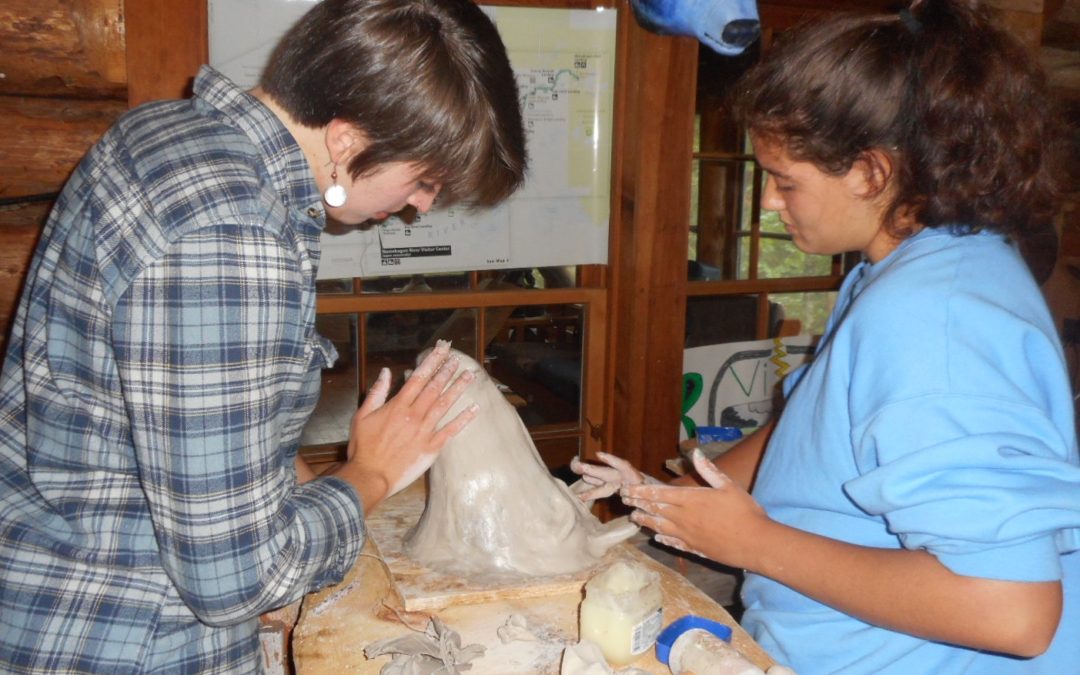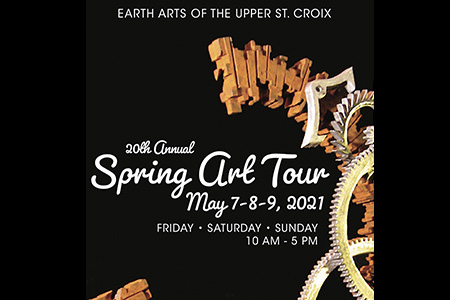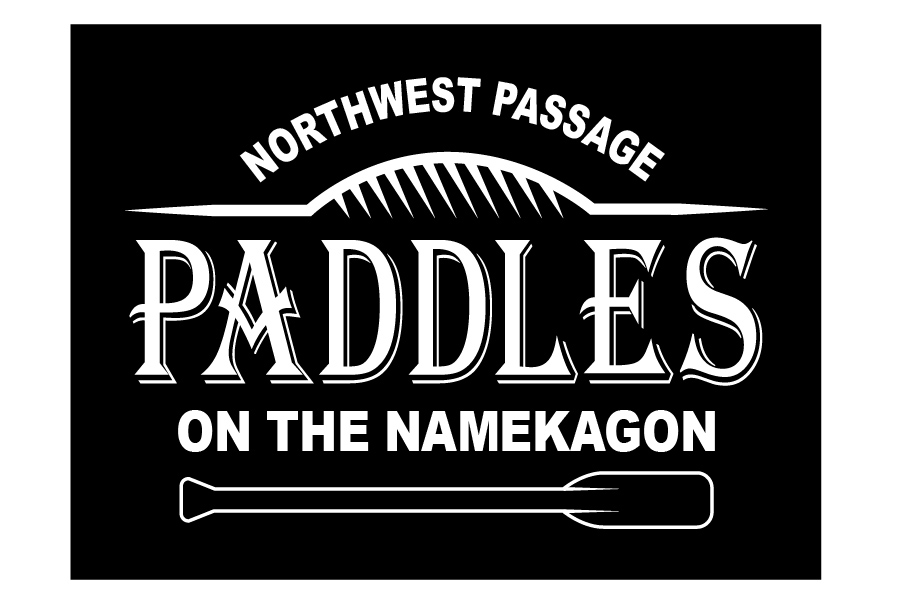Arts bring out kids’ strengths; help them heal
Outside, the world is lushly green, it’s pouring rain, and the tune “Here Comes the Sun” floats through the room. There’s a low murmur of voices: nine girls are engaged in shaping animal figures out of clay or drawing fish figures on cardboard. Occasionally there’s laughter at a comment from the instructor’s baritone. You can feel it’s a happy place.
That’s exactly one of the outcomes Ian Karl aims for by having Chris Lutter-Gardella as Northwest Passage’s August Artist-in-Residence at the remote Schaefer Cabin located in the Namekagon River watershed. Ian is Northwest Passage’s Experiential Program Coordinator in charge of the program.
The Artist-in-Residence program is one of several NWP art programs that evolved from the organization’s 39 year history of promoting a therapeutic lifestyle for their clients. Over the last six years, art has emerged as a strong component of Northwest Passage’s mission. So much so, that one mile south of Webster on State Road 35 NWP opened the In a New Light Gallery.
Puppets, masks relate to nature
The Gallery features the kids’ art – primarily nature photography – and is open to the public. Why that name? Because through this program the clients are able to see the world around them in a new light and see themselves in a new positive light: capable and creative. That’s a fulfillment of the NWP mission: to restore hope through innovative health services for at-risk children and families.
But back to Chris and the girls at the Schaefer Cabin. During his four-week session from July 17 to August 14, thirty-two boys and girls ages 6-17 in four separate groups, came to the cabin in shifts, working on art projects, described by Chris: “We’re creating masks, puppet art pieces and props that relate to the natural world here in the northwoods and also globally that will appear in a music video called Life is Better With You.”
The content is consistent with each group. There are three projects: making masks with clay and paper mache, building insect puppets, and creating fish figures In addition to the educational connection with nature, Chris demonstrates conservation and environmental responsibility by using primarily repurposed and recycled industrial materials.
He explains: “For the bumblebees, which was our kick-off/warm-up project with the boys the first week, we used plastic bottles that I got from a bottling company down by Stillwater. Wire clothes hangers we used for handles and legs; plastics from mattress bags we repurposed into bee wings.
“For the fish, we’re using recycled cardboard boxes; we’ll put scales on them made out of heavier plastic packaging from the furniture industry. The clay forms are mostly recycled clay from the ceramics industry – clay that can’t be fired that typically ends up being dumpster-ed. Newspapers and paper bags we use for the paper mache, with burlap for the fringes around the masks.”
Chris connects the projects to cosmology – the nature of the universe: “The bumblebees are our connection with the air. We call them the ‘Keepers of the Air.’ The animals we’re making like the bear, the cougar and other creatures we consider ‘Keepers of the Land,’ and the fish are the ‘Keepers of the Water.’ That encourages the kids to think in terms of elements and different realms the animals help take care of.”
Some of the girls worked in pairs to create masks of various animals, real and imagined: cougar, bear, elephant, and dragon. Candice and Lorena were working on the dragon. Candice commented on the art project: “I like it. I feel like it’s a way to express your feelings, and it’s a good way to cope with how you’re feeling, too, and how to interact with people. It makes me feel like I can do something that I wasn’t able to do before.”
She said she and Lorena like the reemergence of the dragon in popular culture and they wanted to bring one to life. Candice added, “It also represents fire, and I feel like no one else has fire as an animal, so, we’re like, ‘let’s do a dragon.’”
Attitudes turn around
Chris has worked with youth in the past. He observed, “The girls are just loving it. They’re really getting into sculpting the clay forms for the masks. They seem really invested and dedicated, excited about their pieces. When the art projects are completed, Chris explains, “We’ll take the kids outside and do some fun playing with the masks and props in the woods and along the [Namekagon] river and get some video of that.”
Cassie Bauer, a summer intern and student in Digital Media Production at Drake University is documenting and producing the video. Musician Kathryn “Kat” King is providing the accompanying music. The final film will be a rendition of Michael Frante’s Life is Better With You. It will premiere at the Taste of the Trail event at the In a New Light Gallery on September 23rd.
The residual and significantly more important outcomes are reflected in the kids’ turn-arounds of attitudes and feelings. Ian noted, “Every one of the kids involved seemed happy doing what they were doing. They were smiling, fully engaged. This sort of activity allows them to separate from their problems, they can block out other noise in the world and focus on the task at hand.”
“When we’re engaged in things we enjoy, get fulfillment from and see the results of our work, we’re happier, content and feel a sense of achievement. This fits in to the idea of taking a strength based approach to problem solving. When you help kids find their strengths and give them opportunities to thrive, the mental health challenges they’re facing have the potential to take a back seat. Being engaged in tactile art in a unique location where you can physically feel you’re leaving your troubles behind is really powerful and beneficial.”
He continued, “If we consistently focus on the kids’ problems, the mental health challenges and the diagnoses, then all the energy goes into focusing on that. But if we can help them find their strengths and what they have to offer others, they are happier, more content and work better together as a group. And that’s exactly what we see going on at the cabin. When you go to a unique place like [Schaefer Cabin] and are guided by a professional artist with the constant, calm, consistency and experience that Chris provides – that is priceless.”
[end]




Recent Comments